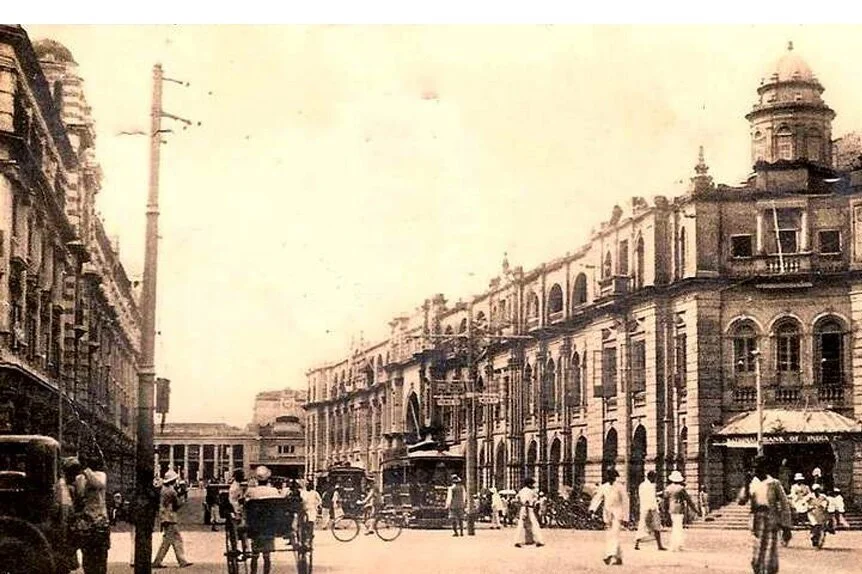Mary Morey Pearson, MD
Mary Morey was born in February of 1861 in Colombo, Sri Lanka (Ceylon). Her father William (1837-1908) was a sea captain who had been born in Hampden, Maine. Her mother Francina Perrera (1837-1901) was from Colombo. William was appointed first United States Consul to Sri Lanka in 1873 and he served there until his death in 1908. “William was a very successful horse racer on Galle Face Green 1866-1873; he was an auctioneer, commission agent, and farrier.” (From Flower Road and family history by Richard Sherman)
View of Main Street in Colombo - the Grand Oriental Hotel is on the right
William and Francine had 4 children; Mary was their eldest and only daughter. She was followed by William (1864-1916), Thomas Prescott (1868-1937) and Elmer Lake (1870-1920). Elmer went on to become the Vice and Deputy Consul to Sri Lanka on 5 April 1893, serving with his father. Thomas was a dentist in Brookline and William was an engineer spending much of his career in Washington DC. He was the chief engineer of the Alaskan topographical expedition in 1899 and oversaw secret map work of the War department in the Spanish-American War.
We don’t know about Mary’s early life or education, but she graduated from the Boston University School of Medicine in 1885. BU’s School of Medicine was first founded in 1848 as the Boston Female Medical College (the name was later changed to the New England Female Medical College). It was the first all-female medical school in the world. In 1872, there had been a devastating fire and the school was nearly bankrupt when Boston University took over (and made their new medical school co-ed).
Mary married Benjamin Pearson on December 15, 1887, in Boston. Benjamin had left home in Hantsport, Nova Scotia sometime when he was a teen. He grew up in a household with a master shipbuilder father. George Nelson Person was purported to be “a cruel and unforgiving father”. Ben was able to live with his Uncle Jacob Pearson in Dorchester. Jacob had a thriving box-making business on Farnham Street in Roxbury. Ben honed his craft as a woodworker there on Farnham St.
In 1891 Mary organized a fundraiser to support the new Homeopathic Dispensary at the Boston University School of Medicine. She seems to have leaned strongly towards the homeopathic field of medicine throughout her career. Mary became the Medical Director of the American Benefit Society in 1902. Her husband Ben was appointed to the Committee on Appeals and Grievances for the same fraternal organization. By 1907 Benjamin owned his own mill. His mill was one of a few that had established new union wages and conditions. His business was added to the Carpenters District Council‘s “blacklist” against union carpenters & woodworkers who went on strike at 7 mills, including Benjamin’s.
By 1910 Ben and Mary had purchased a home at 45 Eliot Street in Jamaica Plain and they lived here for the rest of their lives. In 1913 Mary was elected Supreme Medical Director of the American Benefit Society.
In the late summer of 1912, it appears Mary was subjected to an alleged incidence of racism. Her husband Ben was put on trial for beating up a member of the Benefit Society who purportedly called Mary racist names.
By 1918 we find Mary listed as the President of the American Benefit Society and she was a member of the Advisory Council of the National Woman’s Liberty Loan Program. Liberty Bonds, also known as Liberty Loans, were introduced in the United States in 1918 and were sold to support Allied war efforts during World War I. The idea that this investment could create financial security for citizens was a novel one and subscribing to them became a symbol of patriotic duty.
In 1924 Ben was once again defending Mary’s honor, and not making friends with his neighbors at the same time. It seemed that over the years Ben displayed a temperament not unlike that of his father’s. He was arraigned in the West Roxbury Court on a charge of being a common railer and brawler. He was accused of losing his temper when a dog ran into their flower garden. His defense was that Mary was very afraid of dogs and he needed to defend their property. Several neighbors testified against him, the judge continued the case hoping peace and cooperation might prevail.
In their later years Mary and Ben spent a lot of time in Bermuda according to family stories. They never had children of their own and left a lot of their wealth to Ben’s nieces and nephews; children of his brothers Abijah, also of Boston and Will who had kept the family farm going back in Nova Scotia. We do not know about the relationships they had with Mary’s family.
Mary died on August 12, 1931 in JP at the age of 70, and was buried in her father’s hometown of Hampden, Maine.
Mary in her later years, in the yard at 45 Eliot Street
This article was contributed by Heather Miller in August 2021 (Heather is a descendant of the Pearson family)




